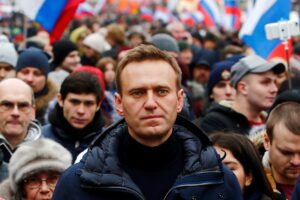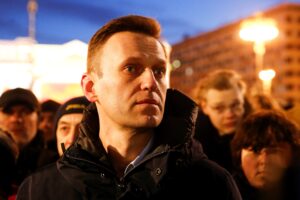
Putin doesn’t care how many of his troops die. He is looking to win a war of attrition. On the second anniversary of Russia’s invasion, Ukraine needs the West’s help — and it needs it now.
February 2024
The second anniversary of Russia’s 24 February 2022 invasion finds Ukraine in a precarious position. Its much-anticipated summer 2023 counteroffensive failed. Quarrels over strategy have riven its political and military elites. Its pool of soldiers — both volunteers and those within reach of the draft — has begun to dry up. Its economy is in shambles. Its allies’ willingness to keep arms flowing is in doubt. Finally, and perhaps most distressingly, Ukrainians’ conviction that they can and will win has been shaken. What happened during the war’s second year to explain this depressing summation?
Over the past year, Moscow has been able to convert its major size advantages into battlefield gains. Russia has a bigger economy, a bigger arms industry, and a bigger population than Ukraine has. Even if the Ukrainian high command had avoided all dubious decisions, there is only so much that Kyiv’s generals can do with the troops and weapons they have and with such arms and supplies as Ukraine’s Western allies are able and willing to send. The mid-February 2024 Russian capture of Avdiivka — a small city in the center of Donetsk Oblast that resisted the attacks of Moscow-backed separatists and Russian troops for a decade — was not only Moscow’s first major victory since the May 2023 fall of Bakhmut (about 75 kilometers to the north), but a blow to Ukrainian morale. With their overwhelming advantage in manpower and ammunition, the Russians dominated the battle’s endgame: As General Oleksandr Tarnavsky, the commander of Ukraine’s southern forces, tells it, the enemy was “advancing on the corpses of their own soldiers with a 10-to-1 shell advantage.”
The biggest change in the past year has been the Russian military’s ability to learn from its mistakes — shoddy logistics, unsuitable and badly maintained equipment, failure to arrange “defenses in depth” — and adapt to war’s hard school. The Ukrainians adopted electronic weapons and unmanned aerial vehicles early, but the Russians closed the gap and cut the effectiveness of Ukrainian drones and precision weapons by dispersing potential targets, learning how to jam communications, and scrambling GPS signals. Over the winter of 2022–23, Russian troops built deep and well-designed defensive zones — layers of antitank ditches, concrete “dragon’s teeth,” landmines, and prepared firing positions — that would prove too much for Ukrainian attacks to breach. As a result, the conflict has become something akin to the trench warfare of World War I, with defenses dug in and without openings for successful offensive breakthroughs.
In other words, this is now a war of attrition. Neither side can hope for more than incremental gains that will cost it many lives. The longer the war lasts, the more it favors Russia. Vladimir Putin can draw on a population that is more than triple the size of Ukraine’s, and an economy that is ten times as big. While Ukraine’s ammunition stocks have been so depleted that officers had to ration bullets to the defenders of Avdiivka, Russia has plenty of weapons and munitions for its artillery and infantry. Moreover, although Western sanctions took a bite out of Russia’s economy early on, Moscow adapted quickly and found ways to dramatically increase war-industry output. A Ukrainian source has made a preliminary claim that Kyiv was recently hit by one of Russia’s new hypersonic Zircon missiles. The speed of these weapons threatens to overwhelm air defenses, a sign of Moscow’s gathering superiority in missile warfare.
For Ukraine, maritime operations continue to be the bright spot. Since the invasion, Kyiv has enjoyed spectacular success at destroying Russian warships — Ukrainian sources claim to have sunk or disabled more than twenty vessels, or about a third of the Black Sea Fleet. These included, in mid-February 2024, the Caesar Kunikov, a large landing ship (used to put troops and vehicles directly on a beach) that was sunk by naval drones — small robot speedboats packed with explosives. Ukraine’s success at making the Black Sea unsafe for Russia’s navy has allowed the creation of a transport corridor that commercial ships can use to reach the port of Odessa. Given the large share of Ukrainian coastline that Russia has seized, maintaining maritime access to this crucial seaport must be counted as a key strategic goal.
Autocracies and Democracies at War
The conflict in Ukraine demonstrates the differences between how democracies and autocracies fight their wars. Even a transitional democracy such as Ukraine must heed political and institutional norms and processes, public opinion, and international humanitarian law. An autocracy such as Putin’s Russia need not bother with such concerns. To illustrate, take a look at three aspects of the war in Ukraine.
Civil-military relations. The Russian polity has structural advantages that Ukraine cannot mitigate let alone overcome. In a dictatorship, there is no need for bargaining between political and military elites. Putin conveys his strategic priorities to his generals, and they do what they can to deliver what he wants. Russia has no meaningful representative body — the State Duma is Putin’s rubber stamp — so there is no substantive debate over policies and their outcomes. With near-total state control of the media, there is no need to explain truthfully how the “special military operation” (Putin has made it illegal to call it a war) is going. Public opinion is ignored, intrepid demonstrators are jailed, and regime critics are murdered, all with impunity.
The head of a democratic state enjoys no such luxuries. Ukrainian president Volodymyr Zelensky must deliberate with his military leaders, as he did with General Valery Zaluzhny, whom he dismissed in early February. The general insisted that Ukraine needs about half a million fresh troops to remain viable in the war, which he called a “stalemate.” That annoyed the president, who understandably likes to project a more positive mindset.
The personal closeness to Zelensky of General Oleksandr Syrsky, the new top military officer, is worrisome as it could restrain the frankness of his counsel. He was also behind what may be Ukraine’s biggest military mistake so far: the mid-2023 effort to retake Bakhmut, which failed while eating up vital resources that could have been better applied elsewhere. Zelensky needs to hear the truth from his soldiers even as he must try to keep up his people’s morale, commitment, and willingness to sacrifice, a challenging task when news from the front is discouraging. Even though some democratic processes, such as elections, are discontinued for the duration of the war, he is responsible to an electorate that may well vote him out of office when given the chance.
Manpower. Putin does not need to justify the tremendous human toll his war has taken. Russia has historically displayed high tolerance for wartime casualties. Moscow has not published death and casualty figures since the beginning of the war, but it has exhibited “striking indifference toward its soldiers as it sacrifices huge numbers to make small gains across the 600-mile front.” In late January 2024, a CIA report claimed that Russia had lost 315,000 dead and wounded troops, or about 87 percent of the total with which it started the war. In 2023, Russia filled out its ranks with poorly trained conscripts — many of them criminals and ex-convicts — in order to launch what some Ukrainians deride as a “meat storm”: waves of “disposable forces who can overwhelm and exhaust Ukrainian soldiers before more talented Russian troops arrive.”
The Russian push for more troops has been highly uneven geographically and socially: Soldiers often hail from poorer groups and regions, with army pay exceeding what can be earned at home. Moscow, St. Petersburg, and other big cities of “mainland” Russia show few signs of military mobilization. When soldiers are hurt or wounded, they receive superficial medical care aimed at returning them to the front without delay. According to Artem Katulin, the head of a Russian combat-medicine training program, half the 2023 Russian war deaths came from injuries that were not life threatening, while a third of amputations were caused by improperly tied tourniquets.
President Zelensky, by contrast, must agonize over recruitment decisions. Of the hundreds of thousands of volunteers who signed up in the early days of the war, only the most severely injured have been discharged. Many Ukrainian soldiers have been on combat duty for two years. Resting and rotating troops is imperative, as Gen. Zaluzhny frequently warned, but has not been addressed until recently. Corruption in the draft system poses yet another difficulty. The urge to avoid service in the trenches led to such widespread bribery that, in August 2023, Zelensky fired the head of each regional draft office.
In early February 2024, the Verkhovna Rada, Ukraine’s legislature, passed a much-awaited mobilization bill that set out “transparent rules for the mobilization process, as well as necessary regulation of the rights of military personnel and conscripts.” The bill grants up to fifteen days of annual leave during martial law (which Zelensky declared when the invasion began), requires that new recruits undergo two to three months of training, and proposes to replace mandatory military service for citizens aged 18 to 24 with a required five months of training whose start date the trainee can choose.
Ukraine, of course, has a much smaller pool of potential recruits than Russia and is already afflicted by demographic problems: After the economic depression of the 1990s and low birth rates, Ukraine has three times as many men in their forties as in their twenties. The situation is so dire that a bill in the Rada would have the government pay to freeze the sperm of young men who are worried about dying in combat. The desperate search for soldiers has led recruitment officers to occasionally raid gyms and shopping centers and pluck young men from their villages without warning. At the same time, Zelensky must also consider the demands of an economy starved of labor by the military’s manpower needs and the exit (for safety abroad) of millions of working-age people.
Allies and helpers. Autocracies at war tend to seek out other dictatorships as allies, or at least as neutral powers that will helpfully conduct their neutrality with a pro-autocracy “lean.” Moscow has overcome the bite of Western sanctions with the crucial help of partners in Abu Dhabi, Beijing, New Delhi, Pyongyang, and Tehran who willingly sell Russia drones, ammunition, and goods it could not procure elsewhere while buying Russian minerals, petrochemicals, and other exports (often at discount rates). With the exception of India, all these states are full-fledged autocracies whose citizens enjoy few civil or political rights and thus cannot freely protest the actions of their governments.
Ukraine’s allies, however, are all democracies. They are less resolute because they are responsible to their own constituents — including some who are no longer eager to send money and arms to Ukraine — and because they cannot order private defense corporations to ramp up production. The West has promised Ukraine weapons and aid that have not been delivered, or which arrived too late to make a difference on the frontlines. NATO and the EU have been hamstrung by recalcitrant member states — Prime Minister Viktor Orbán’s Hungary has been the main culprit — with veto power. The EU found a way around Hungary’s opposition to economic aid worth fifty-billion euros spread over four years. In mid-February 2024, however, Orbán snubbed a two-party delegation of U.S. senators who had gone to Budapest to request that he relax his opposition to military aid for Kyiv and the accession to NATO of Sweden.
The U.S. Congress, meanwhile, continues to debate renewed military assistance to Kyiv, with a number of Republican Party legislators seeking to link the passage of Ukraine aid to reform of U.S. immigration law. Western officials have warned that without Washington’s support, “a cascading collapse along the front is a real possibility later this year.”
Russia now holds the strategic initiative, and it is difficult to see how Ukraine, facing a shortage of troops and ammunition, can regain ground anytime soon. As defense analyst Stephen Biddle contends, a “favorable outcome for Ukraine in a war of attrition is not impossible but will require its forces to outlast a numerically superior foe in what could become a very long war.” Given Russia’s advantage in troops and materiel, Putin can safely play the game of endurance even with modest territorial gains. Without further concentrated, large-scale, and timely assistance from the West, Ukraine cannot win this contest between democracy and dictatorship. ![]()
Zoltan Barany is Frank C. Erwin Jr. Centennial Professor of Government at the University of Texas at Austin and the author, most recently, of Armies of Arabia: Military Politics and Effectiveness in the Gulf (2021). His 2007 book Democratic Breakdown and the Decline of the Russian Military was republished in paperback by Princeton University Press in 2023.
Copyright © 2024 National Endowment for Democracy
Image Credit: YASUYOSHI CHIBA/AFP via Getty Images
| FURTHER READING | ||

The Legacy of a True Russian PatriotAlexei Navalny loved Russia and was willing to risk everything for it. It is hard to grasp the magnitude of his death for his people and his country. |

Why Alexei Navalny Mattered in Life and Still Matters in DeathVladimir Putin may have imprisoned, tortured, and killed the brilliant opposition leader, but even now Navalny is a threat to the corrupt autocracy he has built. |

What Putin Fears MostForget his excuses. Russia’s autocrat doesn’t worry about NATO. What terrifies him is the prospect of a flourishing Ukrainian democracy. |
